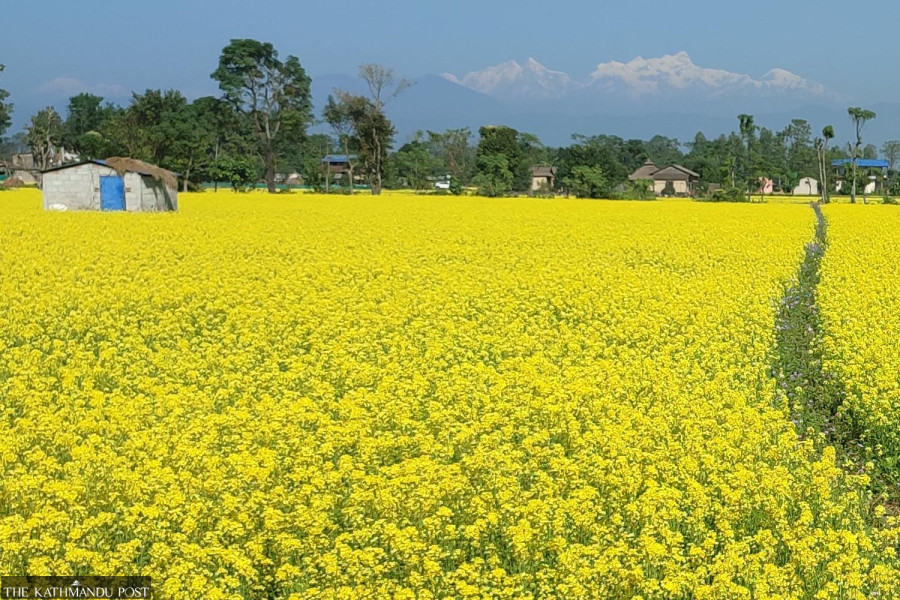Money
Chitwan fields in yellow bloom as mustard makes a strong comeback
This fiscal year, the area under mustard farming increased to 21,850 hectares, returning to its 1998-99 level.
Ramesh Kumar Paudel
The real estate boom of 2008 in Chitwan had a direct impact on the cash crop production, particularly mustard, as farmers shifted to commercial vegetable farming amid rapid urbanisation.
1998-99 was a boom time as mustard farming covered 22,996 hectares in Chitwan, according to the report of the Agriculture Development Office, Chitwan, now Agriculture Knowledge Centre.
The production area declined to 11,130 hectares in 2008-09.
Mustard farms are back. Nowadays, vast stretches of land in Chitwan are covered with yellow blossoms.
Lalit Chaudhary of wad 3 of Madi Municipality has planted mustard on 2.5 bigha (1 bigha = 0.67 hectares) this winter, from 1.5 bigha last winter.
“We used to cultivate mustard on 6 bigha two decades ago. We were a joint family then.”
The ownership of the land started getting divided among family members.
The mustard farming too declined as a result, said Chaudhary, 45. Chaudhary family is back to mustard farming.
The government’s data too proves the fact that mustard farms in Chitwan have been on an increasing trend over the last few years.
Umraj Aryal, chief of the Agriculture Knowledge Center, Chitwan, said farmers have started switching to mustard for the last 5 years. “The area has increased sharply since last year.”
According to Aryal, mustard farming in Chitwan covered 12,255 hectares in 2019-20 and increased to 14,765 hectares in the last fiscal year 2022-23.
This fiscal year, starting mid-July 2023, the area under mustard farming has increased to 21,850 hectares.
Agriculture experts say that mustard farming has returned to its previous level, which is good for the country’s economy as Nepal has been importing edible oil worth billions.
Nepal imported 38,195 tonnes of mustard seeds worth Rs3.98 billion in the last fiscal year, which were mostly used by Khokana’s oil mills in Lalitpur.
In Chitwan, farmers have revived mustard farming. The productivity which used to be less than a tonne per hectare, has now increased to 1.3 tonnes per hectare.
Traders and farmers say that mustard farming gained traction in Chitwan due to the growing awareness about its health benefits.
Reports show that India imposed a ban on the sale of mustard seed oil that had repercussions in Nepal too.
In 1998, a mass-poisoning tragedy began to unfold in New Delhi, India. The authorities determined the illnesses were caused by the adulteration of mustard oil.
The symptoms included swelling of the feet, nausea, vomiting, diarrhoea, abdominal swelling, liver toxicity, kidney damage, breathlessness due to retention of fluids in the lungs and death due to heart failure. By early September, the official death toll was 41, and 2,300 people had been affected.
On August 27, 1998, the Indian government banned the sale of mustard seed oil and announced a policy to import foreign soybeans free of protective trade tariffs.
In 2012, in a controversial decision, mustard oil was banned for edible consumption in the European Union, the United States and Canada, principally due to its erucic acid content. The United States Food and Drug Administration’s website claims it contains erucic acid which can cause heart disease if consumed above the prescribed limits.
Its consumption in Nepal also fell.
By 2021-22, Nepal's imports of edible oils stood at Rs120.46 billion—crude soybean worth Rs56.25 billion and crude palm oil worth Rs39.39 billion, mostly to export to India using the loopholes of the zero duty privilege.
For Nepal’s domestic consumption, sunflower oil worth Rs18.10 billion was imported.
“Mustard is appropriate for the agricultural system in Chitwan,” said Madhav Poudel, chief of the Prime Minister’s Agriculture Modernisation Project.
But the expansion of mustard acreage has affected the wheat production areas in Chitwan, he said.
“Wheat requires well irrigation and it takes time to ripe. But mustard requires less irrigation and ripens in a short period which has attracted farmers towards mustard,” said Aryal.
“Mustard farming does not require hard work,” said Chaudhary, the farmer. “The wild animals in Madi forest destroy wheat crops, but do not damage mustard.”
Bikram Sapkota, treasurer of the Chitwan Lok Oil Producers Association, said that mustard oil seed has been in high demand after the Russia-Ukraine war that disrupted supply.
According to Sapkota, mustard seed jumped to Rs17,000 per quintal, from Rs11,000 per quintal after the war started in February 2022.
In Nepal, the mustard oil price reached Rs425 per litre, from Rs230 per litre, he said. “But prices have declined now.”
“The mustard production increased due to the rise in its value,” said Poudel.
From 1990 to 2000, the government encouraged mustard production.
The mustard production increased as a result in Chitwan, said Subash Subedi, senior scientist of the National Oilseed Research Programme.
But from 2000 to 2010, the mustard farm area started to shrink, he said. While urbanisation started at a rapid pace shrinking the agricultural land in Chitwan, farmers who continued agriculture switched to commercial vegetable farming.
“The use of fertiliser was high when farmers started adopting hybrid varieties. The soil fertility degraded. The mustard production was affected,” said Subedi.
Aryal said that the government has again started encouraging farmers for mustard production.
A subsidy of Rs5 million has been provided to 12 agricultural groups this year for mustard seed, fertiliser, pesticide, irrigation and mechanisation purposes, he said.
The statistics of the Ministry of Agriculture and Livestock Development show that Nepal produced 220,250 tonnes of mustard on 198,197 hectares in the fiscal year 2020-21.
According to the Food and Agriculture Organisation of the United Nations, Nepal ranks at the top in mustard seed production globally, followed by Russia and Canada.




 7.12°C Kathmandu
7.12°C Kathmandu1.jpg)













%20(1).jpg&w=300&height=200)
